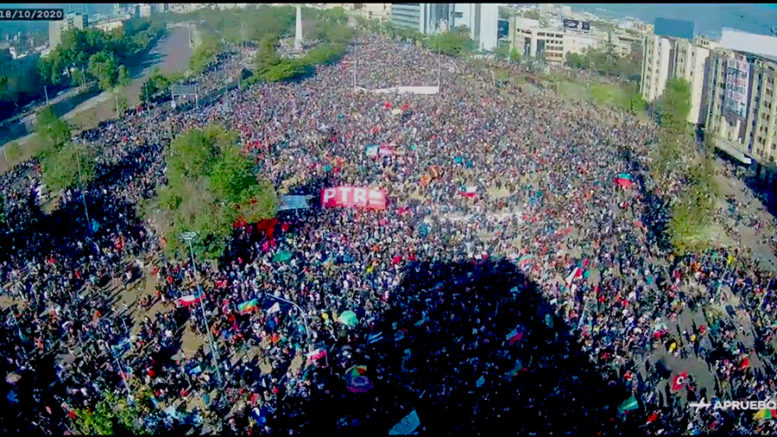Contributed by Joe Montero
Chile’s uprising against the austerity and brutality of President Sabastian Pinera and his government is still going. The first anniversary of the uprising was marked on 18 October.
A year ago, school students reacted against a hike in public transport fares and the brutal police response ignited a national uprising.
A memorial for the dead
Police and military have been used every week to beat down protesters. There have been dozens of deaths. More than 500 have been deliberately blinded. Women in custody have been raped and other forms of torture used. some have disappeared.
Protests originally demanded improvement to pension, healthcare and education systems. This quickly morphed into a call for the resignation of the president and his government, and for a new constitution, to replace one drawn up by General Pinochet and considered designed to keep the regime in control.
The existing constitution is said to be a major factor in state repression, the denial of basic rights, and the impoverishment of a large part of the population.
School student occupation of Metro train station one year ago
The most remarkable affect is that people have lost their fear and are prepared to put their necks on the line, and, state violence have no effective answer to this without resorting to larger scale incarceration killing on the Pinochet’s scale of 1973.
This may not be so easy to impose in the current circumstances. It would require a military takeover, and this would likely spell the end of Pinera and his government as well.
More than three thousand have been arrested and have been held in custody. As the trial dates come, many face the prospect of years of imprisonment. This is spurring others to come out and risk arrest, despite Chile facing one of the worst Coronavirus outbreaks on the continent.
Marking the anniversary, a huge crowd marched and banged pots in the streets of the Capital Santiago. others took Part in other marches across the country.
So far, the rebellion has managed to force a referendum on a new constitution, which is taking place this coming Sunday (Chile time). The campaign is for a “yes” vote.
But there is deep concern that this will be manipulated by those who currently control the political system, to ensure that nothing really changes. The answer has been the additional demand for the new constitution to be framed through assemblies representing ordinary people, instead of leaving in the hands of politicians.
The strengths of the rebellion are that it has struck deep roots in society and becoming better organised in the neighbourhoods, unions, and the community sector.
The 18 October 2020 march in Santiago viewed from the tail end
The slogan of the uprising has been “we have awoken”. Pinera and his government have a serious problem. They have little support from the population, much of which, is not prepared to go back down.
The big stick hasn’t worked. Unless a way is found to convince the unbelieving public that he has changed, there must be an ultimate back down and resignation. This would be a Herculean and highly unlikely feat to achieve.
The best hope to climb out of the trough is, for the traditional political parties to find some sort of accommodation. Behind the scenes maneuvering will be going on, and it remains to be seen whether these parties will be able to stitch up an agreement that protects their monopoly on power and the political institutions that have preserved it so far.
There is no certainty that this will happen or that it will be accepted by the population. The rest remains to be seen.


Be the first to comment on "Chile and one year of uprising against Pinera"